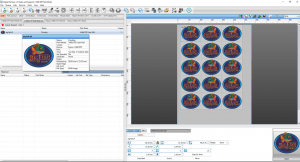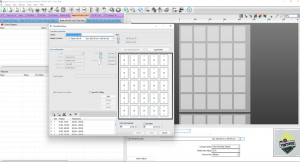 In Digital Factory there are several ways to create multiples of a design. Duplicating or copying a design is a simple process, and there are some powerful options that give you more control over your copies versus traditional copy and paste.
In Digital Factory there are several ways to create multiples of a design. Duplicating or copying a design is a simple process, and there are some powerful options that give you more control over your copies versus traditional copy and paste.
To start, let’s take a look at the following functions of making copies:
- Page copies.
- Copy Group.
- Duplicates.
- Template Copies (with the same slot number.).
AS an example job to follow along with, let’s say we need to print our job 10 times on our DTF Printer. The width of the print should be 300mm and we want to use Page Copies. To get started here:
- Bring the job into the queue.
- Select the job.
- Resize the width to 300mm.
- Click on the “Page” tab in the “Status” menu.
The Page dialogue shows up and under Layout you see the copies Icon. We’ll type in “10” as the number of copies, then reselect the job and press print. 10 pages will now be printed.
We now want to print multiple small labels that are 90mm wide. We select the job, resize it and click the “Copies…” button. A copy has been created and the job dialogue has changed. You can define the numbers of rows and columns or the total number of copies of the copy group and the vertical and horizontal spacing. You can also select “Copy by Area”. If you do not want to type in the number of copies into the dialogue, you can also drag the control nubs to create copies.
We have now created a copy group of 15 labels from our one Job. Copy groups rip the first row, and then the ripped row is placed with the same spacing distance in repetition. The advantage here is that the ripping time is massively reduced, and you can produce a large number of copies.
With the next sample we want to print multiple signs, but some with a different size. We will use duplicates to do so.
- Import and select the job. The job tag shows in the status bar with the “Copies”, “Tiles” and “Duplicate” Buttons.
- Click on “Duplicate”. A dialogue asks how many copies you want to have.
- For our example, let’s choose 6.
- Click “OK”
6 additional jobs have been created. As we have set our “Page Mode” to “Autopage” the jobs are on a page each. All jobs can be sized individually on their page. For example, we can change 2 of the jobs to 75%, 2 to 50% and 2 to 33%.
We want to have all jobs on one page. When no job is selected and the Page tab shows, the “Nest Page” and “Nest All” button are available. When we press “Nest All”, all jobs will be nested. A warning dialogue will appear stating that they current layout will be lost and we are asked if we want to continue. Click yes to continue.
All the duplicates are nested on a page but are still independent. Each job can have a different colour adjustment and can be resized, rotated, mirrored, or tiled. If you want to change the print resolution on a duplicate, it will show red. You either need to change the resolution or bring the duplicate onto another Page.
Tip for working with this: Select the job – Click and hold the CTRL Key and move the duplicate over the Page line. The Job will move to the next page, and the job can be printed with a different resolution separately
Finally we want to explain how to use templates for multiple copies.
 For our printer we have created a template of 24 slots all the same, sized at 80mm x 105mm (Note the label 1 in each slot, all slots will have the same graphic imported).
For our printer we have created a template of 24 slots all the same, sized at 80mm x 105mm (Note the label 1 in each slot, all slots will have the same graphic imported).
When you Import the Job an Import Template Job dialogue shows up. Here, you can select how often you want to import the job and into which slot you want to place the job. You also can deactivate the dialog so that it does not show up each time you import jobs.
We’ll select 1 Copy, which will create 1 page with 24 slots, and press the “Express” button. The template system works in the way that it creates one page. It rips the first template and then places the ripped file on each slot. Our job list shows only one job. You can use Page copies to print multiple pages as shown before
Template slots do not all have to be the same size, you can use templates and print the same image at different sizes and the software will automatically make duplicates instead of copies. For example, we can create two small and two larger copies using a template, as they are different sizes a duplicate is created for the larger copy, so two jobs will be processed.